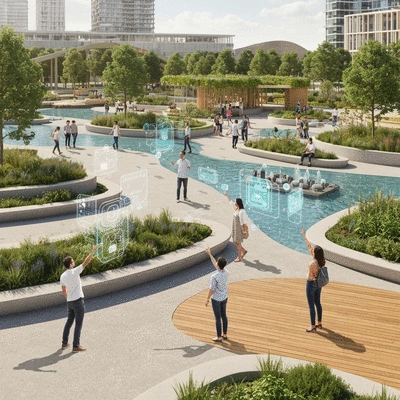
Smart Glasses and Urban Living
As smart glasses and augmented reality reshape our urban experiences, have you considered how these technologies could enhance your daily life? The integration of digital information with our surroundings is not just a trend; it’s a revolution in how we interact with the world. Here are the key insights from this evolving landscape.
What You Will Learn
- Smart glasses utilize augmented reality to overlay digital information directly onto the user's field of view, transforming everyday experiences.
- These devices enhance urban navigation by providing real-time guidance and contextual information to users.
- Popular models, like Google Glass and Microsoft HoloLens, cater to different needs, from enterprise solutions to everyday use.
- Augmented reality fosters community building by enabling shared experiences and social interactions in urban environments.
- The future of smart glasses includes greater accessibility, advanced features, and inclusive design, promising a more connected urban life.
The Synergy of Smart Glasses and Augmented Reality: Key Applications and Examples
This visual highlights the core functionalities of smart glasses, the urban experiences enhanced by AR, and prominent examples of smart glasses on the market.
What Are Smart Glasses?
- 1Display technologies: Microdisplays for augmented overlays.
- 2Sensors: Cameras and motion trackers for environment data.
- 3Connectivity: Link to smartphones or the internet for apps.
AR Enhances Urban Experiences
- AInteractive Tourism: Real-time data on attractions.
- BNavigation Assistance: Turn-by-turn directions on street view.
- CSocial Interactions: Shared AR experiences with friends.
Key Takeaways: Digital & Physical Integration
- •Enhanced Navigation: Real-time guidance.
- •Increased Engagement: Contextual info effortlessly.
- •Community Building: Fosters urban connections.
Popular Smart Glasses
- GGoogle Glass: Enterprise solutions (manufacturing, healthcare).
- MMicrosoft HoloLens: Mixed reality for professionals.
- VVuzix Blade: Lightweight, voice control, camera integration.
Understanding the Intersection of Smart Glasses and Augmented Reality
As we venture deeper into the digital era, the integration of smart glasses and augmented reality (AR) is reshaping our urban landscapes. Smart glasses are more than just a tech novelty; they represent a convergence of technology that enhances our daily experiences. By overlaying digital information onto our physical surroundings, these devices are changing how we interact with the world around us.
But what exactly are smart glasses? Let’s explore their functionality and the role they play in our lives!
What Are Smart Glasses and How Do They Function?
Smart glasses are wearable devices that incorporate a display and various sensors to provide information to the user in real-time. These glasses function by utilizing AR technology to project interactive images and data overlays directly onto the lenses. This technology enables users to receive notifications, access navigation aids, and even engage with social media without looking at their smartphones.
- Display technologies: Most smart glasses use microdisplays to present augmented overlays and information.
- Sensors: Various sensors, including cameras and motion trackers, gather data about the environment and user actions.
- Connectivity: Smart glasses generally connect to smartphones or the internet, allowing seamless access to applications and services.

These devices offer a unique blend of functionality and convenience, making them invaluable in both personal and professional contexts. As someone passionate about understanding digital culture, I find it fascinating how these technologies evolve and adapt to our needs!
The Role of Augmented Reality in Enhancing Urban Experiences
Augmented reality enriches our urban experiences by blending digital elements with the physical world. Imagine walking through a bustling city and seeing historical information about a landmark displayed right in front of you! This fusion opens up a myriad of possibilities for users.
- Interactive tourism: Tourists can access real-time data about attractions, including user reviews and multimedia content.
- Navigation assistance: AR can provide turn-by-turn directions directly onto the street view, simplifying urban navigation. Research published in Frontiers in Virtual Reality highlights how AR can enhance navigation and interaction within urban environments.
- Social interactions: Users can engage with their friends in real-time through shared AR experiences, creating connections that go beyond the physical.
These enhancements not only improve our day-to-day interactions but also shape how we perceive and engage with our environments. At Likers Network, we're dedicated to exploring how these technologies can positively affect our online and offline communities.
Popular Smart Glasses: A Look at Google Glass, Microsoft HoloLens, and Others
Several smart glasses have emerged in the market, each offering unique features tailored to different user needs. Let's take a closer look at some of the popular options available today:
- Google Glass: Initially aimed at consumers, Google Glass has pivoted to enterprise solutions, focusing on hands-free applications for industries like manufacturing and healthcare.
- Microsoft HoloLens: This advanced headset is designed for mixed reality experiences, combining AR and virtual reality, making it ideal for professionals in design and development fields. Recent studies, such as one published in PMC, illustrate the growing utility of AR devices like the HoloLens in various professional settings, including healthcare.
- Vuzix Blade: Known for its lightweight design, Vuzix Blade is great for everyday use, offering features like voice control and camera integration.
As technology continues to evolve, more options are likely to enter the market, each pushing the boundaries of what smart glasses can do. My excitement lies in discovering how these devices will reshape our interactions within urban environments, fostering greater engagement and understanding among communities!
Interactive Poll: Your Thoughts on Smart Glasses
As we delve into the future of smart glasses and augmented reality in urban living, we want to hear from you! How do you feel about the integration of these technologies into our daily lives?
Summarizing the Impact of Smart Glasses on Urban Life
As we wrap up our exploration, it’s clear that smart glasses are revolutionizing the urban landscape. The integration of digital and physical spaces is creating dynamic environments that enhance our daily experiences. We’ve seen how these devices bridge the gap between reality and augmented reality, providing users with instant access to information right before their eyes!
Through this journey, we’ve learned that smart glasses are not just tech gadgets; they’re tools for connectivity, creativity, and even safety. As urban residents, understanding this integration can empower us to navigate our cities with a fresh perspective, making the most of the technology at hand.
What We’ve Learned About the Integration of Digital and Physical Spaces
The fusion of digital and physical realms through smart glasses offers numerous benefits. Here are some key takeaways:
- Enhanced Navigation: Smart glasses provide real-time guidance, making urban navigation intuitive.
- Increased Engagement: Users can interact with their surroundings and receive contextual information effortlessly.
- Community Building: These devices foster connections among users, creating a sense of belonging within urban environments.
As we ponder these points, it's fascinating to consider how our cities are evolving. The synergy between technology and urban life is fostering a culture of innovation and creativity, making daily interactions more meaningful.

Looking Forward: The Future of Smart Glasses in Urban Living
Looking ahead, I can't help but feel excited about the potential of smart glasses in urban living. The future holds a myriad of possibilities:
- Greater Accessibility: With increased adoption, smart glasses will become more affordable and accessible to a broader audience.
- Advanced Features: We can expect enhanced functionalities, from improved AR experiences to seamless integration with other smart devices. The journal Nature, for instance, discusses advancements in AR technology for medical applications, indicating the broad potential for future features.
- Inclusive Design: Developers are focusing on creating user-friendly interfaces that cater to diverse urban populations.
This evolution isn’t just about technology; it’s about creating smarter, more connected communities. As we step into this future, there's a shared responsibility among residents, developers, and city planners to ensure that everyone benefits from these advancements.
Frequently Asked Questions About Smart Glasses and AR in Urban Environments
- Q: What are smart glasses?
- A: Smart glasses are wearable devices that integrate displays and sensors to overlay digital information, such as notifications and navigation, directly onto the user's view of the physical world using augmented reality (AR) technology.
- Q: How do smart glasses enhance urban navigation?
- A: Smart glasses can provide real-time, turn-by-turn directions directly within the user's field of vision, making urban navigation more intuitive and hands-free compared to traditional smartphone-based GPS.
- Q: Can smart glasses improve social interactions in cities?
- A: Yes, augmented reality experiences through smart glasses can enable shared digital interactions among friends in urban environments, fostering new ways to connect and build communities.
- Q: What are some popular smart glasses models and their uses?
- A: Popular models include Google Glass, which is primarily used for enterprise solutions in industries like manufacturing and healthcare; Microsoft HoloLens, designed for mixed reality experiences for professionals; and Vuzix Blade, known for its lightweight design and everyday use features like voice control.
- Q: What does the future hold for smart glasses in urban living?
- A: The future of smart glasses in urban living anticipates greater accessibility, more advanced features, and inclusive designs that cater to diverse populations, leading to more connected and interactive urban experiences.
Engaging with AR: Next Steps for Urban Residents and Stakeholders
As our discussion continues, it’s essential to think about engagement. How can urban residents and stakeholders become active participants in this AR revolution? Let’s explore some actionable steps!
How to Get Involved in the AR Revolution in Your City
Getting involved in the AR revolution can be both exciting and fulfilling. Here are some ways to jump in:
- Join local tech meetups to connect with other AR enthusiasts.
- Participate in workshops and seminars that focus on AR applications.
- Engage with city planning initiatives that incorporate smart technologies.
By taking these steps, you’ll not only expand your knowledge but also contribute to shaping the future of your urban environment. Let’s embrace this opportunity to be part of something bigger!
Staying Informed: Resources and Communities for AR Enthusiasts
Staying updated on AR advancements is crucial for anyone interested in the field. Check out these valuable resources:
- Online Forums: Engage in discussions on platforms like Reddit and specialized AR communities.
- Newsletters: Subscribe to AR-focused newsletters for the latest trends and insights.
- Social Media: Follow AR influencers and companies to see real-time updates and innovations.
By immersing yourself in these communities, you'll gain insights that can enhance your understanding of the evolving AR landscape.
Digital Content Creation: The Future of User Interaction with AR
Looking toward the future, digital content creation will play a significant role in user interactions with AR. The rise of user-generated content means that:
- More individuals will become creators, sharing their unique perspectives.
- Platforms will emerge that allow users to easily design and share AR experiences.
- Collaboration between users and developers will lead to richer, more interactive content.
This shift not only democratizes content creation but also fosters a culture of creativity and innovation in urban environments. As we move forward, let’s keep pushing the boundaries of what’s possible with AR technology!
Recap of Key Points
Here is a quick recap of the important points discussed in the article:
- Smart Glasses Functionality: Smart glasses use AR technology to overlay digital information onto the real world, enhancing user experiences.
- Urban Experience Enhancement: AR enriches urban life by providing interactive tourism, navigation assistance, and real-time social interactions.
- Popular Smart Glasses: Leading devices include Google Glass for enterprise solutions, Microsoft HoloLens for mixed reality, and Vuzix Blade for everyday use.
- Future Prospects: Expect greater accessibility, advanced features, and inclusive designs in smart glasses as technology evolves.
- Community Engagement: Urban residents can participate in the AR revolution by joining local tech meetups, engaging with city planning initiatives, and staying informed through online resources.





Gaming Communities and Digital Culture
Social Media Growth Tactics
Social Media Trends to Watch
Grow Your Audience with Hashtags
Smart Glasses and Urban Living